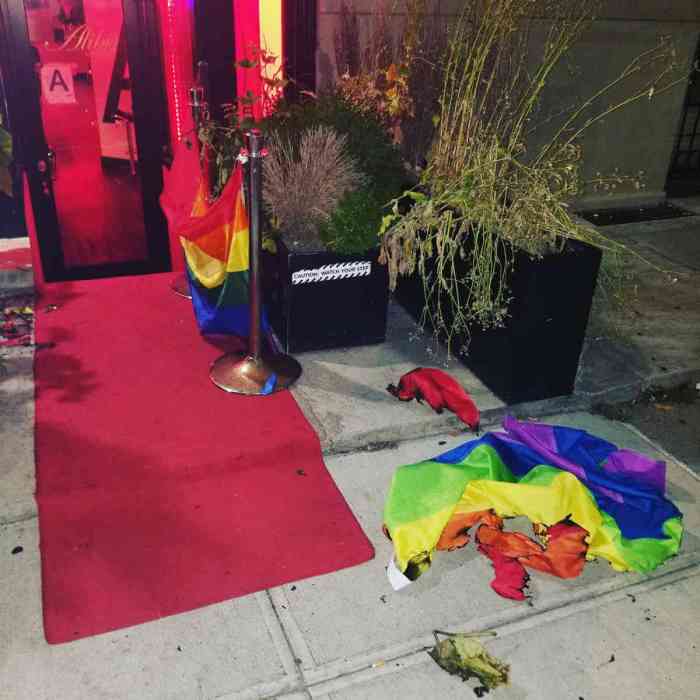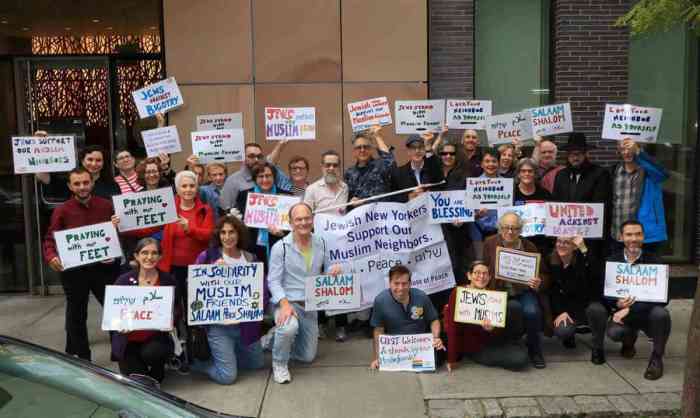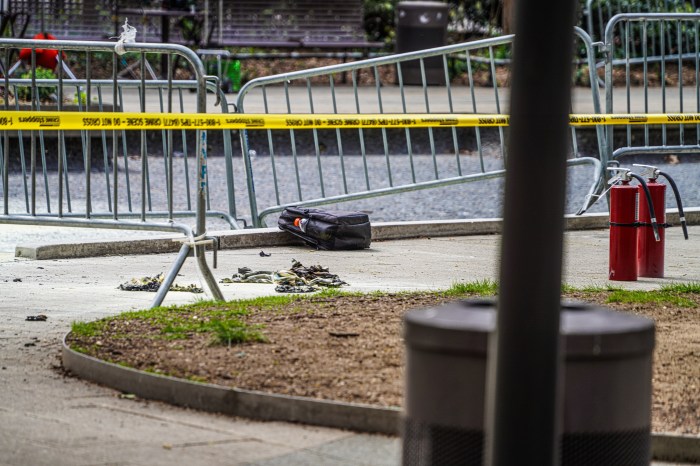The author at his most recent carnival in New Orleans.
BY RABBI ROBERT TEIXEIRA | In the Big Apple, that is, the Big Rush, it was a cold, gray afternoon, but in the Big Easy, it was Mardi Gras! Laissez les bons temps rouler!
I thought of my last carnival, my pouf and chenille ball gown replete with riband (sash), inspired by the tragic Madame Deficit (Marie Antoinette). This year, however, I failed to roll back my routine so I could engage in some time-honored revelry. Katrina’s displacing me had indeed changed things. It’s hardly surprising, then, that the Ghost of Mardi Gras Past visited me.
The Ghost, surrounded by a purple, green, and gold aureole, bellowed, “It’s Fat Tuesday! What’s this? No beads or boobs, krewes or King Cakes, masks or masquerades? Just work, work, work?”
He was quick to remind me that everything had been far easier in the Big Easy. In New Orleans, you see, people don’t live to work or work to live, they work to play! In anguish, I confessed that I was in love with New Yorkers but not New York City, and when I promised to celebrate Mardi Gras next year, the apparition from the Deep South vanished.
The next day, Ash Wednesday, my Episcopagan friend, Kathleen, who had returned to the city after a 17-year hiatus, called to “check in.” I explained to her that I still felt off-center. In my lament, I asked, “Why is it so hard to live in New York City?”
And she answered, “A lot of it has to do with the Hudson River, I think. The Lenape called it Muhheakantuck, ‘the river that flows two ways.’ New York City stands where the fresh and salt water flow into one another, where the New and Old Worlds converge, which makes its energy very dense. The city’s a vortex, a womb for news ideas. Everyone here is trying to give birth to something.”
And I responded, in turn, “I’m imagining pools of water. Whenever people come across a pool, what do they do? They toss a coin in. New York City can be likened to a pool, a very special pool, and a creative idea or dream to a coin. If they succeed at tossing their coins into this pool, they’ll succeed. ‘If I can make it there, I'll make it anywhere.’ But everyone has to roll their coins uphill, which explains why so many people give up before becoming ‘King of the Hill.’”
At this point, both of us laughed and began singing, “I want to wake up, in a city that never sleeps, and find I'm king of the hill, top of the heap.” Soon after, the conversation came to a close.
We had to get back to work, back to rolling our coins uphill. Kathleen had to finish editing the video of a performer whom she’s promoting, and I had to continue writing a book of meditations, to accompany the deck of Psalm Cards that I had created.
When Kathleen’s call had come in, I was very focused on Psalm 21:3: “You have proffered him blessings of good things, have set upon his head a crown of fine gold.” The meditation that I had written, which was based on this verse, read: “The moment you’ve been hoping for has finally arrived! All your hard work is paying off! Countless times, over the years, you’ve told yourself, ‘I’m not good enough! I don’t have what it takes!’ Today, you realize that you’ve been lying to yourself. Go ahead, say it out loud: ‘I am good enough! I have what it takes!’ This stellar achievement proves that you haven’t been deluding yourself. You summoned the courage to believe in yourself, despite the doubt, which swirled in and around you. Celebrate and give to those in need. Whenever we receive, we should give in turn.”
I wanted to include a well-known rabbinic aphorism, found in the Babylonian Talmud, which stresses the importance of charity, or tzedakah, in Jewish practice. “Charity,” says Rabbi Assi, “is equivalent to all the other religious precepts combined” (Baba Batra 9a).
As I was looking up the exact source of this citation, I came across the words of Rabbi Isaac, “He who gives a small coin to a poor man obtains six blessings, and he who addresses to him words of comfort obtains 11 blessings” (Baba Batra 9b). In the rabbi’s words, I heard “what goes around comes around” and “the river that flows two ways,” which Kabbalists sometimes refer to as hok ha gemul.
“If I’m writing about tzedakah,” I thought, “I have to mention Maimonides.” In his Mishneh Torah, he argues that the highest expression of charity is to help someone become self-sufficient so he or she doesn’t have to be dependent on others.
“What else should I add?” I asked myself. I entered into the search bar “Maimonides charity,” and when I clicked on the first page to come up, Maimonides’ Eight Levels of Charity, I was greeted by a watercolor sketch of a coin –– a coin!
It seems that a coin, in one way or another, had been trying to tell me something all day. As I sat quietly and recalled the words of the Ghost of Mardi Gras Past, Kathleen, Rabbi Assi, Rabbi Isaac, and Maimonides, I realized that I had discovered the secret to success in New York City!
If you want to toss your coin in this pool, you have to help someone else do the same. If you want to give birth to one of your ideas or realize one of your dreams here, you have to help someone else do the very same thing.
And you don’t have to look far to find such a person. There is a record number of homeless New Yorkers — more than 60,000, including more than 22,000 children, as of July 2013, according to the Coalition for the Homeless.
Improving your chances of success by helping a homeless person help himself or herself may seem less than altruistic, as it should. True altruism is exceedingly rare, and charity or tzedakah can assume many unique forms.
During the High Holy Days, for example, some Jews donate to their synagogue, that is, distribute tzedakah, in return for the opportunity to participate in services. At one synagogue, the “suggested donation” for opening the doors of the Holy Ark (which houses the Torah scrolls) was $540. According to the synagogue’s website, the segulah, or spiritual benefit, of opening these doors during the concluding service of Yom Kippur is a “long life.”
As Jews everywhere were gearing up for this past weekend’s Purim and thoughts of offering food and charity to those in need filled the air, the timing of my discovery, it seems, couldn’t have been better. Convinced I’ve discovered the secret to success in New York City, I’ve begun reaching out to job training programs that serve the homeless, including the Ali Forney Center, which serves LGBT youth.
To my delight, I learned that I can put someone through barber school for a total of $2,000! The cost of the student tool kit (barbering tools) and the operator’s license, incidentally, is $540 (precisely what that one synagogue was suggesting for opening the doors of the Holy Ark). The good news is that the school has a 10-week program, so I won’t have to wait long for the future barber to make a splash!
Rabbi Robert Teixeira, LCSW, is a psychotherapist and the founder and spiritual director of Uri! Uri!, an emerging chavurah in Brooklyn. To learn more about his work, visit StayBlessedAndBeWell.com.


































